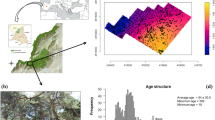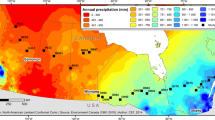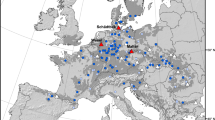Abstract
Forest ground heterogeneity can affect interactions among tree species and control the assembly of local forest communities. Less is known of the effects of spatial heterogeneity on the maintenance of tree genetic variation through small-scale genotype × environment (G × E) interactions. We measured growth variation within and among 17 Betula pendula genotypes, planted in a clear-cut forest site through the summers 2009–2011. We assessed the spatial heterogeneity at two scales: among forest stands having history of the same or different tree species combinations (treated as replicate blocks), and along a gradient of within-block forest density, revealed by the stump density. To add a temporal perspective, we distinguished between old (cut 50 years earlier) and new stumps (cut one year earlier). The broad-sense heritabilities for growth were 0.093–0.055 and the coefficients of genotypic variation 0.37–0.21 in 2009–2011. The growth difference among the genotypes was 3.5–5.5 fold, significant in all years, and the rank of genotype means correlated positively between the years. The most favourable block had 106 % higher growth than the least favourable block and the amount of total variation explained by block increased from 0.4 % in 2009 to 6.9 % in 2011. Genotype × block interaction was marginally significant in 2009, but not later. Similarly, the response of growth to old stump density in sapling vicinity varied among the genotypes in 2009, but not later. In 2010 and 2011, the mean growth increased by 50–91 % along the old stump density gradient. Our results suggest that despite creating significant variation in sapling growth the small-scale forest ground heterogeneity, which reflects the recent forest history, may not significantly contribute to the maintenance of genetic variation in B. pendula populations.





Similar content being viewed by others
References
Atkinson MD (1992) Betula pendula Roth (B. verrucosa Ehrh.) and B. pubescens Ehrh. J Ecol 80:837–870
Beckage B, Clark JS (2003) Survival and growth of three forest tree species: the role of spatial heterogeneity. Ecology 84:1849–1861
Boettcher SE, Kalisz PJ (1990) Single-tree influence on soil properties in the mountains of eastern Kentucky. Ecology 71:1365–1372
Brokaw N, Busing RT (2000) Niche versus chance and tree diversity in forest gaps. Trends Ecol Evol 15:183–188
Clinton PW, Buchanan PK, Wilkie JP et al (2009) Decomposition of Nothofagus wood in vitro and nutrient mobilization by fungi. Can J For Res 39:2193–2202
Crutsinger GM, Collins MD, Fordyce JA (2006) Plant genotypic diversity predicts community structure and governs an ecosystem process. Science 313:966–968
Ferm A, Hytönen J, Lilja S et al (1994) Effects of weed control on the early growth of Betula pendula seedlings established on an agricultural field. Scand J Forest Res 9:347–359
Fischer A, Lindner M, Abs C et al (2002) Vegetation dynamics in central European forest ecosystems (near-natural as well as managed) after storm events. Folia Geobot 37:17–32
Geburek T, Hiess K, Litschauer R et al (2012) Temporal pollen pattern in temperate trees: expedience or fate? Oikos 121:1603–1612
Gómez-Aparicio L, Gómez JM, Zamora R (2005) Microhabitats shift rank in suitability for seedling establishment depending on habitat type and climate. J Ecol 93:1194–1202
Haapanen M (1996) Impact of family-by-trial interaction on the utility of progeny testing methods for Scots pine. Silvae Genet 45:130–135
Häkkinen M, Heikkinen J, Mäkipää R (2010) Tree influence on carbon stock and C: N ratio of the soil organic layer in boreal Scots pine forests. Can J Soil Sci 90:559–566
Hansen TF, Pélabon C, Houle D (2011) Heritability is not evolvability. Evol Biol 38:258–277
Hodge GR, White TL (1992) Genetic parameter estimates for growth traits at different ages in slash pine and some implications for breeding. Silvae Genet 41:252–262
Houle D (1992) Comparing evolvability and variability of quantitative traits. Genetics 130:195–204
Hughes AR, Stachowicz JJ (2004) Genetic diversity enhances the resistance of a seagrass ecosystem to disturbance. PNAS 101:8998–9002
Hynynen J, Niemistö P, Viherä-Aarnio A et al (2010) Silviculture of birch (Betula pendula Roth and Betula pubescens Ehrh.) in northern Europe. Forestry 83:103–119
Imaji A, Seiwa K (2010) Carbon allocation to defense, storage, and growth in seedlings of two temperate broad-leaved tree species. Oecologia 162:273–281
Kanerva S, Smolander A (2007) Microbial activities in forest floor layers under silver birch, Norway spruce and Scots pine. Soil Biol Biochem 39:1459–1467
Kanerva S, Kitunen V, Loponen J et al (2008) Phenolic compounds and terpenes in soil organic horizon layers under silver birch, Norway spruce and Scots pine. Biol Fert Soils 44:547–556
Laitinen J, Rousi M, Tahvanainen J (2002) Growth and hare, Lepus timidus, resistance of white birch, Betula pendula, clones grown in different soil types. Oikos 99:37–46
Laitinen ML, Julkunen-Tiitto R, Tahvanainen J et al (2005) Variation in birch (Betula pendula) shoot secondary chemistry due to genotype, environment, and ontogeny. J Chem Ecol 31:697–717
Olsson BA, Hansson K, Persson T et al (2012) Heterotrophic respiration and nitrogen mineralisation in soils of Norway spruce, Scots pine and silver birch stands in contrasting climates. Forest Ecol Manag 269:197–205
Paluch JG, Gruba P (2010) Relationships between local stand density and local species composition and nutrient content in the topsoil of pure and mixed stands of silver fir (Abies alba Mill.). Eur J Forest Res 129:509–520
Pennanen T, Liski J, Bååth E et al (1999) Structure of the microbial communities in coniferous forest soils in relation to site fertility and stand development stage. Microb Ecol 38:168–179
Poorter L (1999) Growth responses of 15 rain-forest tree species to a light gradient: the relative importance of morphological and physiological traits. Funct Ecol 13:396–410
Reich PB, Tjoelker MG, Walters MB et al (1998) Close association of RGR, leaf and root morphology, seed mass and shade tolerance in seedlings of nine boreal tree species grown in high and low light. Funct Ecol 12:327–338
Reusch TBH, Ehlers A, Hämmerli A et al (2005) Ecosystem recovery after climatic extremes enhanced by genotypic diversity. PNAS 102:2826–2831
Rodríguez RL (2012) Grain of environment explains variation in the strength of genotype × environment interaction. J Evol Biol 25:1897–1901
Rousi M, Pusenius J (2005) Variations in phenology and growth of European white birch (Betula pendula) clones. Tree Physiol 25:201–210
Rousi M, Heinonen J, Neuvonen S (2011) Intrapopulation variation in flowering phenology and fecundity of silver birch, implications for adaptability to changing climate. Forest Ecol Manag 262:2378–2385
Saetre P, Bååth E (2000) Spatial variation and patterns of soil microbial community structure in a mixed spruce-birch stand. Soil Biol Biochem 32:909–917
Sayer EJ (2006) Using experimental manipulation to assess the roles of leaf litter in the functioning of forest ecosystems. Biol Rev 81:1–31
Silfver T, Mikola J, Rousi M et al (2007) Leaf litter decomposition differs among genotypes in a local Betula pendula population. Oecologia 152:707–714
Silfver T, Roininen H, Oksanen E et al (2009) Genetic and environmental determinants of silver birch growth and herbivore resistance. Forest Ecol Manag 257:2145–2149
Silfver T, Autelo M, Paaso U et al (2013) Use of an insecticide in field-scale plant-herbivore studies: no side effects of synthetic pyrethrin on Betula pendula growth or chemistry. Ann Bot Fennici 50:337–346
Siljamo P, Sofiev M, Severova E et al (2008) Sources, impact and exchange of early-spring birch pollen in the Moscow region and Finland. Aerobiologia 24:211–230
Sinkkonen A, Somerkoski E, Paaso U et al (2012) Genotypic variation in yellow autumn leaf colours explains aphid load in silver birch. New Phytol 195:461–469
Stener L-G, Hedenberg Ö (2003) Genetic parameters of wood, fibre, stem quality and growth traits in a clone test with Betula pendula. Scand J Forest Res 18:103–110
Stener L-G, Jansson G (2005) Improvement of Betula pendula by clonal and progeny testing of phenotypically selected trees. Scand J Forest Res 20:292–303
Stratton DA (1994) Genotype-by-environment interactions for fitness of Erigeron annuus show fine-scale selective heterogeneity. Evolution 48:1607–1618
Stratton DA, Bennington CC (1998) Fine-grained spatial and temporal variation in selection does not maintain genetic variation in Erigeron annuus. Evolution 52:678–691
Tanaka H, Shibata M, Masaki T et al (2008) Comparative demography of three coexisting Acer species in gaps and under closed canopy. J Veg Sci 19:127–138
Tikkanen O-P, Rousi M, Ylioja T et al (2003) No negative correlation between growth and resistance to multiple herbivory in a deciduous tree, Betula pendula. Forest Ecol Manag 177:587–592
Ushio M, Kitayama K, Balser TC (2010) Tree species-mediated spatial patchiness of the composition of microbial community and physicochemical properties in the topsoils of a tropical montane forest. Soil Biol Biochem 42:1588–1595
Weber P, Bardgett RD (2011) Influence of single trees on spatial and temporal patterns of belowground properties in native pine forest. Soil Biol Biochem 43:1372–1378
Xiong S, Nilsson C (1999) The effects of plant litter on vegetation: a meta-analysis. J Ecol 87:984–994
Yu Q, Pulkkinen P (2003) Genotype-environment interaction and stability in growth of aspen hybrid clones. Forest Ecol Manag 173:25–35
Zinke PJ (1962) The pattern of influence of individual forest trees on soil properties. Ecology 43:130–133
Acknowledgments
We thank Seija Vanhakoski for the micropropagation work, Pentti Kananen and Markku Ahlquist for field site preparation and the staff in FFRI Haapastensyrjä Unit for participating in planting and site maintenance. We are also grateful to Anni-Mari Pulkkinen for the vegetation survey, Marianne Lehtonen, Viivi Toivio and Santeri Savolainen for laboratory assistance and the anonymous reviewers for many instructive comments on the earlier version of the paper. The study was funded by the Academy of Finland (decision #1122444).
Author information
Authors and Affiliations
Corresponding author
Rights and permissions
About this article
Cite this article
Mikola, J., Paaso, U., Silfver, T. et al. Growth and genotype × environment interactions in Betula pendula: can tree genetic variation be maintained by small-scale forest ground heterogeneity?. Evol Ecol 28, 811–828 (2014). https://doi.org/10.1007/s10682-014-9708-9
Received:
Accepted:
Published:
Issue Date:
DOI: https://doi.org/10.1007/s10682-014-9708-9






